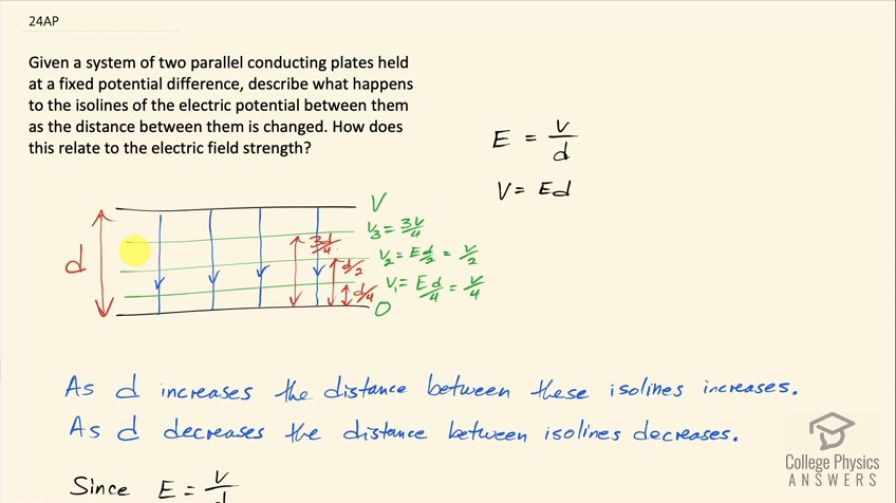Question
Given a system of two parallel conducting plates held at a fixed potential difference, describe what happens to the isolines of the electric potential between them as the distance between them is changed. How does this relate to the electric field strength?
Final Answer
As the separation between plates increases, the distance between isolines of potential also increases. As the separation decreases, the isolines become closer together. The electric field strength decreases as the separation increases.
Solution video
OpenStax College Physics for AP® Courses, Chapter 19, Problem 24 (Test Prep for AP® Courses)

vote with a rating of
votes with an average rating of
.
Video Transcript
This is College Physics Answers with Shaun Dychko. We have two parallel conducting plates that are held at a fixed potential difference and we want to know what happens to these equipotential lines— these isolines of electric potential that are between the plates— as the separation between the plates changes? So the electric field is constant between these plates and so that means these equipotential lines are going to be straight horizontal lines because the meaning of an isoline of electric potential is that there's no work needed to move a test charge along the line. Another way to say that is that there's no component of this electric field that is parallel to the equipotential line because if there was, you'd have to do work against that field if you moved the test charge so these equipotential lines are always perpendicular to electric field lines. Now they are going to be evenly spaced because the potential at any particular point is the electric field strength, which is constant everywhere multiplied by the distance you have gone from this plate of zero potential. So the potential at this first isoline is the electric field times one-quarter the distance I am imagining this is d over 4 here the full separation divided by 4 and so V 1 is V over 4. V 2 is the electric field strength times half the distance which is going to be V over 2 because V is a substitution for Ed, where E is the electric field strength and d is the full separation. And then likewise V 3 is going to be the three quarters of the full potential. So as d increases, the separation between these isolines will also increase because they will be at the same fractional distance, you know, this V 2 will still be halfway between the two plates but now the difference between d over 2 and d over 4 will increase as the plates move further apart and likewise, if d decreases, these isolines will get more closer together. Okay! And the next question is how does this relate to electric field strength? Well, since E is the full voltage divided by the separation between the plates, the electric field will decrease as the separation increases because electric field strength is inversely proportional to the separation. So since E equals v over d, E will decrease as the separation between the plates increases.